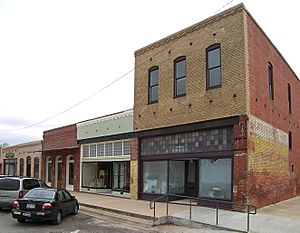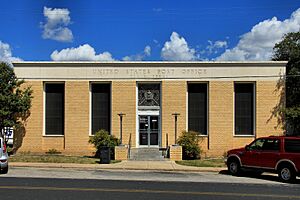Elgin, Texas facts for kids
Quick facts for kids
Elgin, Texas
|
|
|---|---|
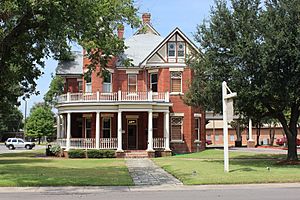
Elgin City Hall is located in the historic Dr. I. B. Nofsinger House
|
|
| Nicknames:
Brick Capital of the Southwest;
Sausage Capital of Texas |
|
| Motto(s):
"Perfectly Situated"
|
|
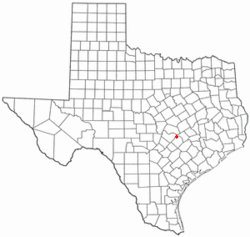
Location of Elgin, Texas
|
|
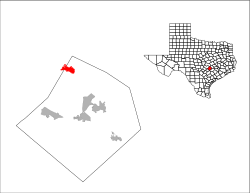 |
|
| Country | United States |
| State | |
| Counties | Bastrop, Travis |
| Incorporated | 1901 |
| Government | |
| • Type | Home Rule, Council-Manager form |
| Area | |
| • Total | 6.62 sq mi (17.15 km2) |
| • Land | 6.62 sq mi (17.15 km2) |
| • Water | 0.00 sq mi (0.00 km2) |
| Elevation | 581 ft (177 m) |
| Population
(2020)
|
|
| • Total | 9,784 |
| • Density | 1,557.77/sq mi (601.49/km2) |
| Time zone | UTC-6 (Central (CST)) |
| • Summer (DST) | UTC-5 (CDT) |
| ZIP code |
78621
|
| Area code(s) | 512 & 737 |
| FIPS code | 48-23044 |
| GNIS feature ID | 1373617 |
Elgin (pronounced EL-ghin) is a city in Bastrop County, Texas, in the United States. In 2020, about 9,784 people lived there.
Elgin is known as the "Sausage Capital of Texas." It also has the nickname "Brick Capital of the Southwest." This is because three brick factories used to operate there in the mid-1900s. Two of them are still open today.
Contents
History of Elgin, Texas
The city of Elgin exists because of a big flood in 1869. This flood happened in the Colorado River. Originally, a railroad was planned to go through a different area.
In 1871, the Houston and Texas Central Railroad built tracks through this area. They set up a "flag stop" called Glasscock. A flag stop was a place where trains would only stop if someone waved a flag to get on or off. It was named after George W. Glasscock, a local resident.
On August 18, 1872, Glasscock was renamed Elgin. It was named after Robert Morris Elgin, who worked for the railroad. It was common to name new railroad towns after company officers. Elgin officially became a town.
The town grew as people moved from nearby Perryville, which the railroad had bypassed. Perryville was also known as Hogeye. Legend says the fiddler at dances there only knew one song, "Hogeye."
By 1879, Elgin was a busy town with about 400 people. It had a newspaper, a gin (for cotton), and a gristmill (for grinding grain). In 1884, Thomas O'Conner started a brick-making business. This led to Elgin becoming known as the "Brick Capital of the Southwest."
In 1885, a new railroad line was planned to connect Taylor, Elgin, and Bastrop. The "Katy" Railroad bought this line and extended it to Houston. This meant Elgin had two major train lines. Eight passenger trains came through daily! This helped Elgin become a big shipping point for cotton, wool, and livestock.
By 1890, Elgin had 1,100 people. It had hotels, a broom factory, doctors, a dentist, and a newspaper. In the early 1900s, coal mining nearby also brought more people to the area.
In 1901, Elgin officially became an incorporated city. This meant it had its own local government. Charles Gillespie was elected as the first mayor. The city continued to grow steadily throughout the 20th century.
By 1940, Elgin had two large brick and tile factories. During World War II, the nearby army training base, Camp Swift, helped the town's businesses. A third brick company opened in the 1950s because of the good clay in the area.
Elgin also became famous for its sausage. A local sausage factory processed thousands of pounds of meat each week. Elgin became an important farming center in Bastrop County. Other businesses included processing feed and grain.
By the 1980s, people who worked in Austin started moving to Elgin. The city was still known for its sausage and brick factories.
Downtown Elgin
The Elgin Commercial Historic District covers 14 city blocks. It has many old commercial and industrial buildings. Most of these buildings were built between 1872 and 1947 using local bricks. This district was added to the National Register of Historic Places in 1996. This means it's a special place worth preserving.
Many buildings in the downtown area have been restored. The Elgin Main Street Program helps building owners with things like discounted paint and advice on how to restore old buildings.
Elgin became a "Texas Main Street city" in 1990. It was also chosen as a "National Main Street Community" in 1999, 2000, and 2001. The Main Street program helps save historic downtown areas.
Geography
Elgin is about 25 miles east of downtown Austin. It is also 18 miles north of Bastrop. It sits where U.S. Highway 290 and State Highway 95 meet. Most of Elgin is in Bastrop County, but parts extend into Travis and Williamson Counties. The northern part of Elgin is built on rich, dark soil called "blackland prairie soil."
Climate
Elgin has hot, humid summers. Its winters are usually mild to cool. This type of weather is called a humid subtropical climate.
Demographics
| Historical population | |||
|---|---|---|---|
| Census | Pop. | %± | |
| 1910 | 1,707 | — | |
| 1920 | 1,630 | −4.5% | |
| 1930 | 1,823 | 11.8% | |
| 1940 | 2,008 | 10.1% | |
| 1950 | 3,168 | 57.8% | |
| 1960 | 3,511 | 10.8% | |
| 1970 | 3,832 | 9.1% | |
| 1980 | 4,535 | 18.3% | |
| 1990 | 4,846 | 6.9% | |
| 2000 | 5,700 | 17.6% | |
| 2010 | 8,135 | 42.7% | |
| 2020 | 9,784 | 20.3% | |
| U.S. Decennial Census | |||
| Race | Number | Percentage |
|---|---|---|
| White (NH) | 3,101 | 31.69% |
| Black or African American (NH) | 1,538 | 15.72% |
| Native American or Alaska Native (NH) | 11 | 0.11% |
| Asian (NH) | 47 | 0.48% |
| Some Other Race (NH) | 34 | 0.35% |
| Mixed/Multi-Racial (NH) | 302 | 3.09% |
| Hispanic or Latino | 4,751 | 48.56% |
| Total | 9,784 |
In 2020, there were 9,784 people living in Elgin. There were 3,033 households and 2,158 families.
In 2010, the population was 8,135 people. About 57% of the people were White, 17% African American, and 45% were Hispanic or Latino.
In 2000, about 29.8% of the people were under 18 years old. The average age was 32 years.
Arts and culture
The Chamber of Commerce is located in the original 1872 Houston and Texas Central Railroad building.
There is a mural called Texas Farm in the Elgin Post Office. It was painted by Julius Woeltz in the 1930s. The mural shows people harvesting vegetables and picking corn.
Sports
In 2006, the Elgin Major Girls softball team placed third in the Softball World Series. This big competition was held in Portland, Oregon. The next year, in 2007, the Elgin Little League's Major Girls' softball All-Stars finished in second place in the Little League World Series.
Education
Elgin is served by the Elgin Independent School District. This school district covers over 168 square miles. It includes parts of Bastrop, Lee, Williamson, and Travis Counties. In 2010, about 4,000 students attended schools in this district.
A branch of Austin Community College opened in Elgin in 2013. This college offers classes for older students.
Media
Many movies have been filmed in Elgin, including:
- 1974 The Texas Chain Saw Massacre
- 1975 The Great Waldo Pepper
- 1993 What's Eating Gilbert Grape
- 1993 A Perfect World
- 1995 The Big Green
- 1996 Michael
- 1999 Varsity Blues
- 2002 25th Hour
- 2002 The New Guy
- 2003 The Alamo
- 2006 A Scanner Darkly
- 2014 Transformers: Age of Extinction
- 2015 My All American
- 2018 Fear the Walking Dead
- 2019 Mercy Black
Notable people
- Ray Culp, a famous baseball pitcher
- Jake Helgren, a film director, producer, and screenwriter
- Chester Snowden, an artist and illustrator
- Otho Davis, a football trainer
- Erika Thompson, a beekeeper
See also
 In Spanish: Elgin (Texas) para niños
In Spanish: Elgin (Texas) para niños



